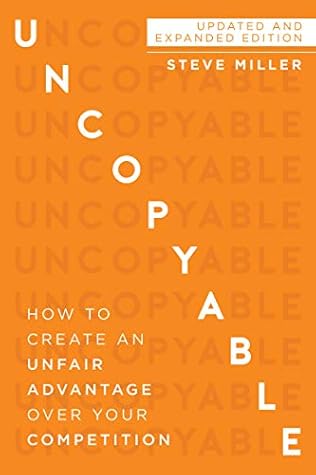More on this book
Community
Kindle Notes & Highlights
But you don’t want to be better, because better can always be bettered, ad infinitum. The only way to climb off of the wheel is by becoming Uncopyable—demonstrably, clearly, undoubtedly, measurably, meaningfully Uncopyable. You just haven’t figured out how that works yet.
That’s the new reality, gang. In today’s world, if something can be copied, it will be copied.
However, “better” is temporary.
As I said, if it can be copied, everybody will copy it.
Developing an Uncopyable advantage requires creating a strategy with new, contrarian eyes—looking at your industry, your competitors, and
especially your customers, through a different filter.
In a word—attachment: your customer’s attachment to you.
When you create attachment, you not only best your competition but also leave them scratching their heads and eating your dust.
That’s an Uncopyable Mind-Set: looking at something everybody else sees but seeing something different.
My reply is, “Look at what everybody else is doing and don’t do it.”
Achieving Uncopyable status requires a consciously developed practice of observation and curiosity and an almost contrarian perspective. Instead of following the leaders in your market, break away from them by creating new rules of competition they can’t or won’t play under—as Hamilton does.
And don’t fall into the trap of thinking you can just ask your customers what they want that’s different. I
Your customers don’t know what they want. They know they want something be...
This highlight has been truncated due to consecutive passage length restrictions.
My all-time favorite quote about this came from Henry Ford: “If I’d asked
people what they wanted, they would have said faster horses.”
You start with your market.
The better job you do of matching the message to your market, the more success you’ll have.
Have you ever heard about the guy in Anchorage who took a set of tires to Nordstrom and asked for his money back?
The salesman contacted the manager, and after some discussion, they determined this guy was a very good customer.
So they refunded his money even though Nordstrom do...
This highlight has been truncated due to consecutive passage length restrictions.
The tire story speaks to an ideal of superior, even unbelievably high, customer service.
Smart companies understand the power of myth.
You see, the essence of your brand is the big, specific promise you make to your customers. What promise can you make that resonates with your target audience?
If you truly want to innovate you must put yourself outside your comfort zone, exposing yourself to alien experiences (my words).
And the following happen when you create incredible experiences for your customers:
A richly imprinted experience wants to be repeated.
A richly imprinted experience wants to be remembered.
A richly imprinted experience wants to be shared.
Regardless, the point is you need to look for ways to get your customer attached to you, both professionally and personally.
If you can create a mental picture of your ideal customer, it makes it much easier to think like your customer. An important distinction to make here is the difference between a prospect and a lead.
The better we are at understanding what our market is thinking, the easier it will be to develop a relationship.
Now imagine you come up with a message only you can say, only you can promise, only you can deliver. That’s where the concept of Uncopyable comes in.
It’s your branding proposition: your big promise.
It makes a clearly stated promise as to how you differentiate yourself from the competition, one that resonates powerfully with your moose.
But your branding proposition goes beyond uniquely identifying your products and services. It not only makes a clearly stated promise; it also makes you memorable to
Branding clearly differentiates you from the competition. Branding establishes your credibility with your marketplace. Branding resonates with your moose. Branding makes a unique promise. Branding makes you the logical choice for your target market. Branding makes you memorable.
For many of us, even names such as Kawasaki, Yamaha, Honda, or Suzuki would all be in that same box. Why? Because the messages and experiences we’ve received from those manufacturers, over the years, are all pretty much the same.
The idea of creating an effective branding proposition is that it’s not that you’re trying to think outside the box; you’re trying to create your own box, one that’s completely separate from the others.
That’s what you want to do: build your own box and fill it with the things that will resonate with your moose, things that keep you out of that big generic box your competitors are all in.
If your promise isn’t all that unique, maybe your personality is. When you’re looking to break out of the scrum of sameness, trying to determine a brand or a branding proposition, you might come up with a promise and use that personality to make it stick—and stick out.
Own a Word or Phrase.
Take ownership of a word or a phrase, something that connects
to your p...
This highlight has been truncated due to consecutive passage length restrictions.
Consider all the different types of tools you could use to anchor your promise in the mind of the customer or prospect and trigger the memory of your name.
Once you create that language, it’s yours. And everyone you interact with will associate those words and phrases with you alone.
What type of shock-and-awe package can you produce to send to prospects, to new customers?
His groundbreaking idea was extrinsic benchmarking, studying aliens: you study people and organizations and businesses that have no relationship to your world at all.
Peter Drucker, who’s generally acknowledged to be the godfather of modern corporate management, used to say there were only two things a corporation needed to do really, really well.
One was marketing, and the other was innovation,
Innovation is closer to game changing than it is to incremental upward movement.


